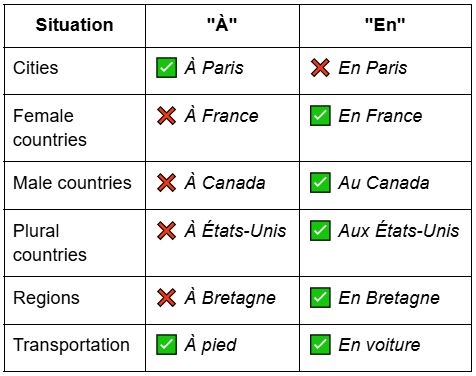When to use « en » and « à » in French?
Introduction
Do you hesitate between « en » and « à » when speaking French? These two prepositions often come up in everyday language… and regularly cause doubt, even for the most advanced speakers.
Good news: there are simple rules for knowing which one to choose depending on whether you’re talking about a place, a means of transportation, or a specific situation. In this article, you’ll learn how to use them correctly, avoid common mistakes, and improve your written and spoken expression.
1. The preposition « À »
📌 As a general rule: we use « à » for cities and certain specific locations.
Examples:
- ➤ Je vais à Paris.
- ➤ Elle habite à Londres.
- ➤ Nous partons à Madrid demain.
💡 Tip: Whether the city is big or small, « à » is always used (à Tokyo, à Marseille, à Nice).
We can find “à” in common expressions like:
- ➤ Être à la maison 🏠
- ➤ Aller à l’école 🎒
- ➤ Travailler à la banque 🏦
- ➤ Être à la plage 🏖️
- ➤ Aller à pied 🚶
Now you know that when you want to say “I am going to Paris”, you have to use the preposition “à” in French: “Je vais à Paris”.
2. The preposition « En »
Now let’s move on to the use of the preposition “en”.
📌 As a general rule, we use « en » before feminine names of countries, regions, and means of transportation.
Examples:
- ➤ Je pars en Italie.
- ➤ Ils habitent en France.
- ➤ Nous voyageons en Bretagne.
💡 Tip: If the country name ends in -e, it is usually feminine and we will use « en » (en Espagne, en Allemagne, en Argentine).
We can find “en” in front of means of transport like:
- ➤ Voyager en voiture. 🚗
- ➤ Partir en avion. ✈️
- ➤ Aller en métro. 🚇
Remember that when you want to say “I am going to France”, you have to use the preposition “en” in French: “Je vais en France” because “France” is a feminine country name.
3. Special cases and exceptions ⚠️
Now let’s move on to special cases and exceptions:
👉 Masculine countries: If a country is masculine, we use « au » instead of « en. »
Example: Je pars au Canada / Il vit au Brésil.
👉 Plural countries: We use « aux » for plural countries.
Example: Je vais aux États-Unis.
👉 The islands and certain regions:
- ➤ We say « à Cuba« , « à Madagascar » but « en Corse« .
- ➤ For the larger islands, we prefer « en » (en Sicile, en Sardaigne).
👉 Means of transportation:
- ➤ We use « à » for à pied, à vélo, à moto, à cheval.
But we say en train, en bus, en voiture.
4. Summary table 📊
Here is a summary table of the rules in French that we have just seen:

Conclusion
As you’ve just seen, choosing between « en » and « à » is not arbitrary. You just need to know a few basic rules and pay attention to special cases.
Get into the habit of spotting these prepositions in your reading or speaking, and test them out in your own sentences. The more you use them in the right context, the more natural they will become.
Guide for beginners
French: where to start?
This guide with the basics of French will allow you to:
✨ Know how to get started learning French
✨ Quickly acquire basic conversational skills
✨ Be able to get by during a first trip to France
Ready to start your apprenticeship? Let’s go !

Information
Legal notice
GTC
Customer reviews
FAQ

